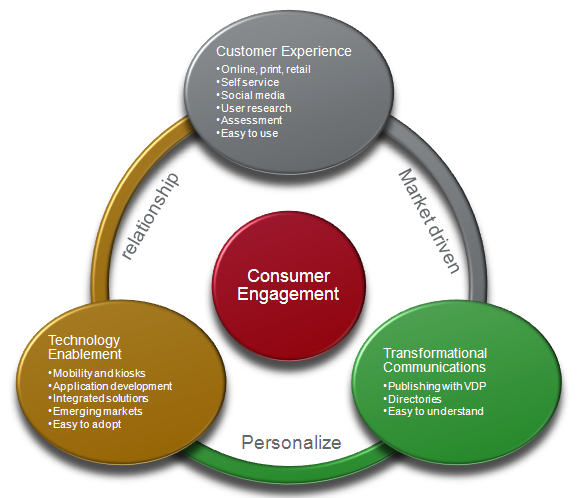
As a whole, healthcare organizations want to improve patient and member outcomes and help those people achieve their desired outcomes. Whether it’s an older patient wanting to stay healthy enough to live independently, or a child needing a set of ear tubes to reduce the frequency of ear infections, each patient has unique needs that require attention to detail.
That said, there’s a wide gulf between how patients perceive themselves and their relationships with healthcare organizations. How can healthcare organizations engage collaboratively with their patients and members in order to achieve their goals and help them become more engaged in their own health journey? And how can healthcare organizations keep up with the digital trends in the healthcare sector to meet those goals?
Health Engagement is a Cycle
Health Affairs says patient engagement is a concept that combines a patient’s knowledge, skills, ability, and willingness to manage his own health and care with interventions designed to increase activation and promote positive patient behavior. The problem some healthcare organizations find is, some patients don’t really want to engage with providers around their health unless there’s a critical condition that presents itself, such as a heart attack, stroke, or cancer diagnosis–many of which could have been less severe had preventative measures been taken prior to the diagnosis.
Patient engagement is a repeatable cycle with opportunities for engagement at multiple points to improve patient outcomes. Healthcare organizations can influence patients to achieve successful outcomes – if they can approach patients with their needs in mind.
We see three types of health interventions that each offer unique openings to the patient engagement conversation. For each type of opportunity, patients have different “jobs to be done” and will interact with the healthcare system in different ways:
- Health monitoring – flu shots, vaccinations, screenings, and check-ups. The patient’s “job to be done” is to complete the encounter successfully, one time.
- Immediate/acute need – accidents, broken arms, lacerations, strokes. With these events, the patient’s “job to be done” is to restore health and functionality, with multiple encounters over a defined period of time.
- Chronic need – treating chronic diseases like diabetes, hypertension, or obesity, or recovery from surgery, heart attack, or another event. With chronic needs, the patient’s “job to be done” may be defined more individually and over a longer time period. One patient might want to achieve a “cure”, or return to pre-event functioning. Another patient may seek to manage symptoms and have a good quality of life.
Four Rules for Better Engagement
Before healthcare organizations engage with a patient and provide helpful ideas and activities, it’s useful to think through the rules of engagement from the patient’s view. Patients want to achieve their healthcare goals, and don’t always realize that engagement with their providers can help achieve this, thus, the need for easy engagement programs. By starting from the patient view and designing the experience she or he wants, healthcare organizations can initiate contact from a position of trust and empathy.
Rule #1 – Help Patients Match Quickly
Does your organization make it easy for patients to understand their benefits? Can they quickly find the right physicians to match their needs? Are appointments available soon enough? Technology such as Artificial Intelligence (AI) physician matching for provider directories, online scheduling, and web visits can help smooth the process.
Rule #2 – Work with the Whole Person
Once a patient engages in a clinical setting, the goal of treating the whole person and identifying issues to better health outcomes begins. This includes clinicians taking the time to understand root causes that may touch on social determinants of health, not just current symptoms, and seeing the whole picture of health. Their discovery process should be collaborative and multi-disciplinary, leveraging colleagues, experts, and data sets. With this, an individualized plan for patient success can be developed, that continues after a patient leaves the exam room.
Working with not only the patient, but also their family, friends, and other support systems can help professionals with changing patient mindsets throughout the process, leading to profound and lasting impacts.
Rule #3 – Be Accessible
In healthcare, patient access typically refers to whether a person can schedule an appointment and get to a facility within a reasonable timeframe. For patients in a rural setting, this can mean a long drive to a healthcare facility that may keep them away–or for those unable to drive, just finding transportation to see a provider in person.
This calls into play the ability of telehealth to help foster patient engagement for those who can’t physically be in a physician’s office very easily.
This also calls attention to clinician activities in the office–was the clinician distracted? If the patient presented new concerns or different information, did the clinician reconnect at the moment? In a world of increasingly impersonal medical technology, patients seek the human inside the white coat to guide them through any anxiety and confusion.
Rule #4 – Review and Revise
Building feedback loops explicitly for patient engagement in the interdisciplinary practice will help reinforce the habit among clinicians. Such loops can provide opportunities to review how patient engagement strategies are working with patients and their families, as well as chances to revise strategies as a patient’s condition or support ecosystem changes. The feedback loop can help patients internalize the clinical solutions provided by their physicians, and create a sense of empowerment and capability.
Want to learn more?
If you’re attending the MedCity Engage conference in San Diego on November 2018, Bob Yurkovic will be speaking on these topics, and more during his November 6 session.
